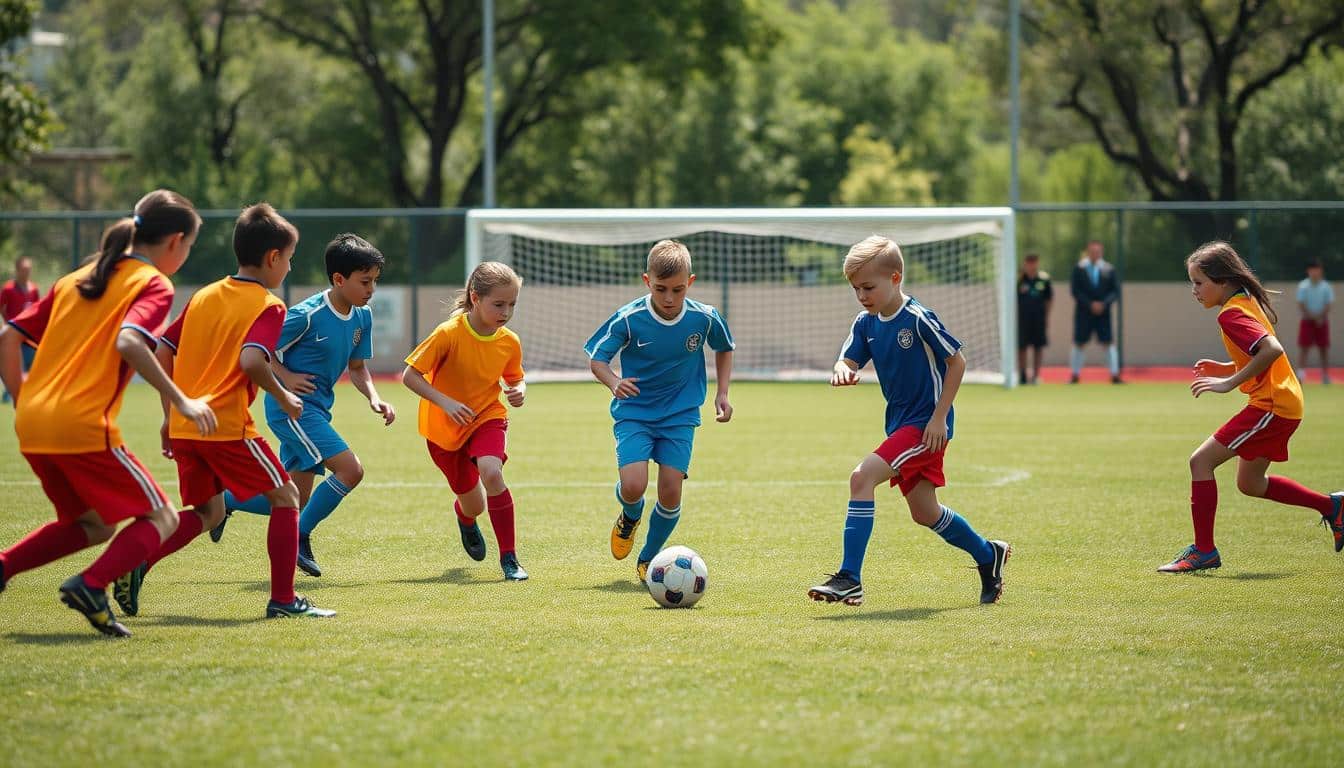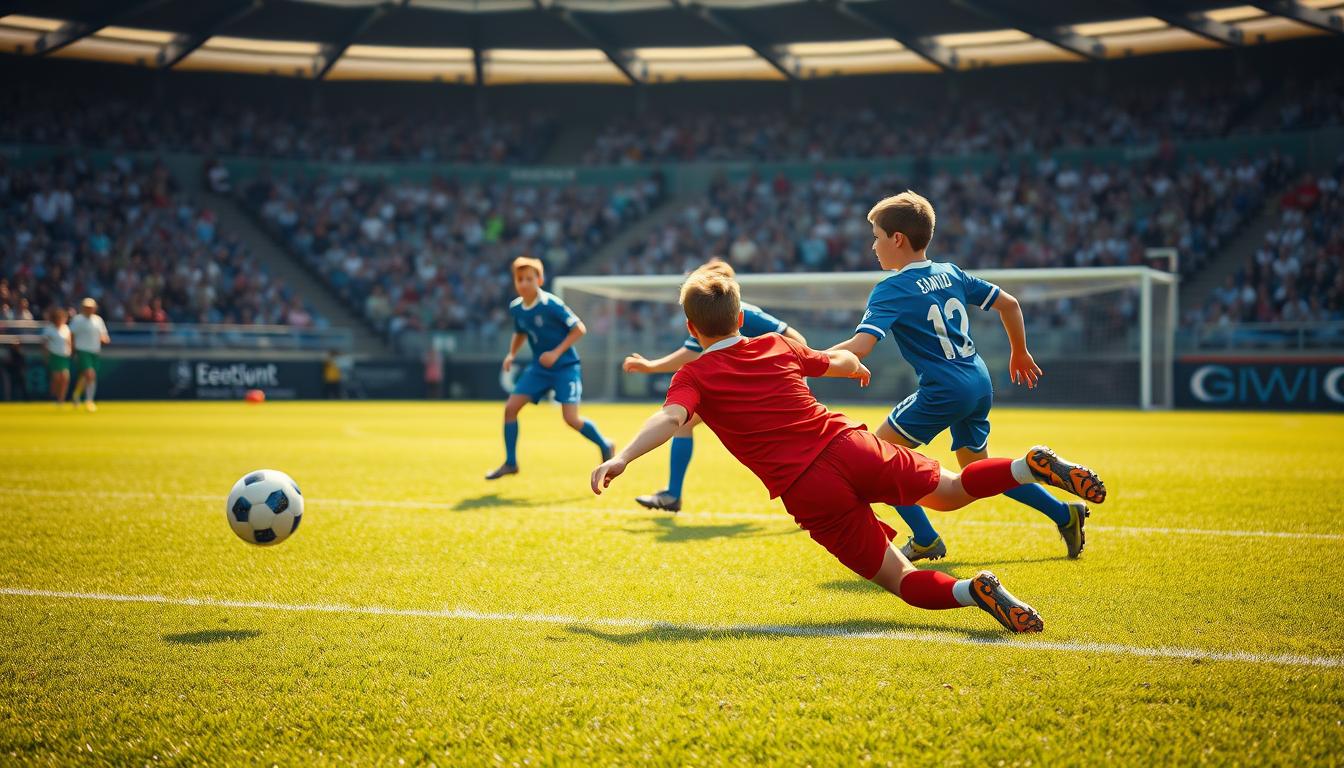Choosing the Right Soccer Position for Kids

With over 5 billion global fans, soccer thrives on teamwork and smart player placement. Your young athlete’s enjoyment often depends on matching their natural talents to one of four core roles: defenders, midfielders, forwards, or goalkeeper. Unlike many sports where size dominates, soccer positions reward quick thinking and communication skills as much as physical ability.
Watch how your child interacts during drills. Do they instinctively protect their zone? Maybe defense fits. Do they create scoring chances? Forward could be their sweet spot. The right role helps them shine individually while boosting team performance. Remember – early choices aren’t permanent as skills develop.
Key Takeaways
- Soccer success relies on matching mental strengths to field roles
- Position selection impacts both enjoyment and team results
- Communication skills outweigh pure athleticism in most cases
- Game observations reveal natural position tendencies
- Versatility grows when trying multiple roles early
- Physical attributes matter less than in other youth sports
Understanding Soccer Positions and Their Roles
Every player on the field has a special job that keeps the team working like clockwork. You’ll find three main groups of positions: those who protect, those who control, and those who attack. The goalkeeper stands apart as the only player allowed to use hands within their penalty area.
Breaking Down the Field Zones
Defenders form the team’s shield. Center backs and fullbacks block the opposing team from advancing. They tackle, clear danger, and start counterattacks. Watch how they communicate – their role demands constant awareness.
Midfielders act as the engine room. They shuttle between defense and attack, distributing the ball with precision. Central midfielders often dictate game tempo, while wingers stretch play wide. Their stamina lets them cover more field area than any other position.
Essential Position Partnerships
Forwards and midfielders combine like puzzle pieces. Strikers need service from creative midfielders, while wingers rely on overlapping fullbacks. Notice these key connections:
- Goalkeepers direct defenders during set pieces
- Center backs pair up to cover aerial threats
- Defensive midfielders protect backline gaps
Modern soccer requires flexibility. Players might start as wingers but track back to help defenders. This fluid system helps teams adapt during matches. Position numbers (like #9 for strikers) help coaches assign roles quickly during drills.
Factors to Consider for Your Child’s Role on the Field
Finding the best fit for young athletes involves more than physical traits. Soccer thrives when players align their mental strengths with their role on the field. Unlike basketball or football, success here depends heavily on decision-making and adaptability.
Skill Assessment and Stamina
Watch how your child interacts with the ball during drills. Do they conserve energy or push through fatigue? Right-wingers, for example, often run 6-7 miles per game – stamina matters here. Track their performance in later practice periods versus early sessions.
Natural instincts reveal hidden talents. Kids who position themselves strategically without coaching might excel in defensive roles. Those creating chances from tight spaces could thrive as attacking midfielders.
Mindset, Communication, and Teamwork
Notice if your young athlete directs peers or works quietly. Goalkeepers need vocal leadership, while strikers focus on precise movements. Team dynamics shift based on these personality traits.
Resilience separates good players from great ones. Does your child reset quickly after a missed pass? Defenders face constant pressure – their ability to recover mentally impacts the whole team.
How to choose a soccer position
Soccer success starts when personal strengths align with on-field duties. While other sports prioritize size or speed, this game rewards mental sharpness and adaptability. Your young athlete’s ideal role emerges from their unique mix of instincts and traits.
Watch where your child gravitates during casual play. Do they organize peers instinctively? That leadership ability suits center backs. Quiet observers with quick reflexes might thrive as goalkeepers. Natural problem-solvers often excel in midfield roles.
Balance physical traits with mindset. A fast runner could play wing, but if they dislike constant sprints, consider defensive positions. Stamina matters more than pure speed for box-to-box midfielders.
Rotate players through different spots during practice. Try these approaches:
- Track where they position themselves without coaching
- Note which skills they use most naturally
- Observe communication patterns during scrimmages
Most young athletes benefit from exploring multiple positions before specializing. This builds game understanding and reveals hidden talents. Work with coaches to create rotation opportunities while explaining how each job helps the team succeed.
Exploring Defensive Roles for Young Players
Defensive roles shape a team’s backbone, requiring focus and tactical awareness. These positions demand players who thrive under pressure while protecting their goal. Let’s break down key responsibilities for young athletes in these critical roles.

Goalkeeper and Its Unique Duties
The goalkeeper stands as the last line of defense with special privileges. Only this player can use hands within the penalty area to block shots. Quick reflexes and strong communication prove essential for organizing defenders during attacks.
Successful goalkeepers anticipate opponents’ moves and command their box fearlessly. They develop leadership skills by directing teammates and making split-second decisions. This role suits athletes who enjoy high-pressure situations and can bounce back quickly from setbacks.
Fullback and Center Back Roles
Center backs form the defensive core through physical presence and game intelligence. These players need strength to win aerial duels and stamina to maintain positioning. Their organizational skills help maintain defensive shape throughout matches.
Fullbacks balance defensive duties with attacking support. They work closely with wingers, covering wide areas and initiating counterattacks. This dual responsibility requires exceptional field awareness and endurance.
| Position | Key Skills | Game Impact |
|---|---|---|
| Goalkeeper | Reflex saves, distribution | Prevents 80-90% of goal chances |
| Center Back | Tackling, positioning | Wins 70%+ aerial challenges |
| Fullback | Speed, crossing | Covers 5+ miles per game |
Young defenders learn responsibility through these roles. Mistakes here often lead directly to goals, teaching valuable lessons in concentration. Defensive positions build resilience and teamwork that benefit players both on and off the field.
Midfield Roles and Their Benefits for Young Athletes
Midfielders serve as the team’s heartbeat, connecting defense and attack while shaping game flow. These players develop critical thinking and adaptability – skills that translate beyond the field. Their dual responsibilities make midfield positions ideal for building well-rounded athletes.
Central Midfielder Functions
Central midfielders act as playmakers, directing passes and controlling tempo. They intercept opponents’ moves while launching counterattacks. This role demands sharp vision to spot openings and quick decisions under pressure.
Young athletes here learn to read the game like chess. They master both defensive tackles and creative through-balls. Constant movement improves stamina – central midfielders often cover 7+ miles per match.
This position builds leadership as players coordinate teammates across zones. It’s perfect for kids who enjoy problem-solving and varied challenges. Rotating through midfield roles helps young athletes discover their strategic strengths while boosting team chemistry.
